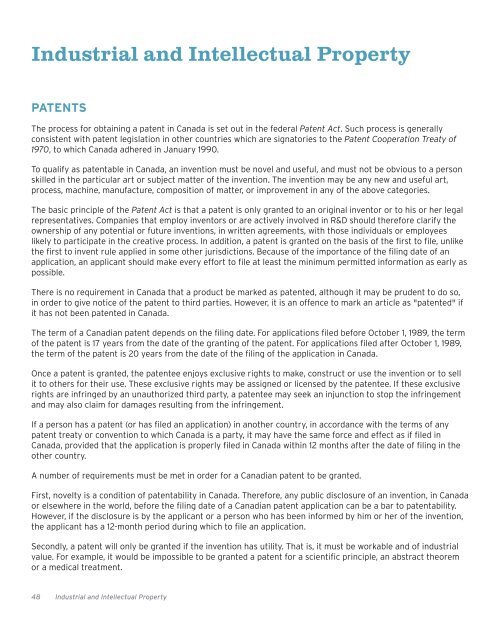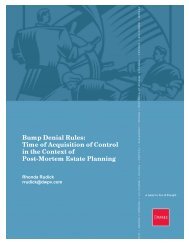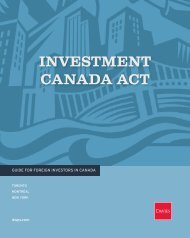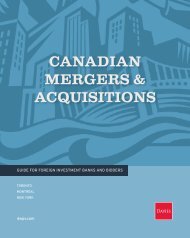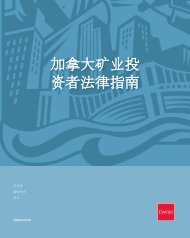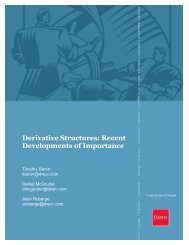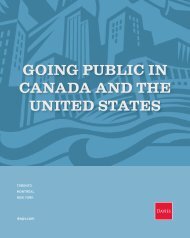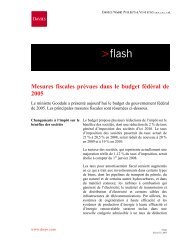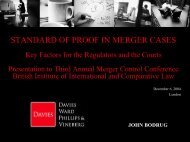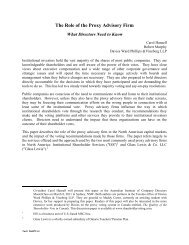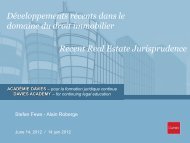doing business in canada - Davies Ward Phillips & Vineberg LLP
doing business in canada - Davies Ward Phillips & Vineberg LLP
doing business in canada - Davies Ward Phillips & Vineberg LLP
- No tags were found...
You also want an ePaper? Increase the reach of your titles
YUMPU automatically turns print PDFs into web optimized ePapers that Google loves.
Industrial and Intellectual PropertyPATENTSThe process for obta<strong>in</strong><strong>in</strong>g a patent <strong>in</strong> Canada is set out <strong>in</strong> the federal Patent Act. Such process is generallyconsistent with patent legislation <strong>in</strong> other countries which are signatories to the Patent Cooperation Treaty of1970, to which Canada adhered <strong>in</strong> January 1990.To qualify as patentable <strong>in</strong> Canada, an <strong>in</strong>vention must be novel and useful, and must not be obvious to a personskilled <strong>in</strong> the particular art or subject matter of the <strong>in</strong>vention. The <strong>in</strong>vention may be any new and useful art,process, mach<strong>in</strong>e, manufacture, composition of matter, or improvement <strong>in</strong> any of the above categories.The basic pr<strong>in</strong>ciple of the Patent Act is that a patent is only granted to an orig<strong>in</strong>al <strong>in</strong>ventor or to his or her legalrepresentatives. Companies that employ <strong>in</strong>ventors or are actively <strong>in</strong>volved <strong>in</strong> R&D should therefore clarify theownership of any potential or future <strong>in</strong>ventions, <strong>in</strong> written agreements, with those <strong>in</strong>dividuals or employeeslikely to participate <strong>in</strong> the creative process. In addition, a patent is granted on the basis of the first to file, unlikethe first to <strong>in</strong>vent rule applied <strong>in</strong> some other jurisdictions. Because of the importance of the fil<strong>in</strong>g date of anapplication, an applicant should make every effort to file at least the m<strong>in</strong>imum permitted <strong>in</strong>formation as early aspossible.There is no requirement <strong>in</strong> Canada that a product be marked as patented, although it may be prudent to do so,<strong>in</strong> order to give notice of the patent to third parties. However, it is an offence to mark an article as "patented" ifit has not been patented <strong>in</strong> Canada.The term of a Canadian patent depends on the fil<strong>in</strong>g date. For applications filed before October 1, 1989, the termof the patent is 17 years from the date of the grant<strong>in</strong>g of the patent. For applications filed after October 1, 1989,the term of the patent is 20 years from the date of the fil<strong>in</strong>g of the application <strong>in</strong> Canada.Once a patent is granted, the patentee enjoys exclusive rights to make, construct or use the <strong>in</strong>vention or to sellit to others for their use. These exclusive rights may be assigned or licensed by the patentee. If these exclusiverights are <strong>in</strong>fr<strong>in</strong>ged by an unauthorized third party, a patentee may seek an <strong>in</strong>junction to stop the <strong>in</strong>fr<strong>in</strong>gementand may also claim for damages result<strong>in</strong>g from the <strong>in</strong>fr<strong>in</strong>gement.If a person has a patent (or has filed an application) <strong>in</strong> another country, <strong>in</strong> accordance with the terms of anypatent treaty or convention to which Canada is a party, it may have the same force and effect as if filed <strong>in</strong>Canada, provided that the application is properly filed <strong>in</strong> Canada with<strong>in</strong> 12 months after the date of fil<strong>in</strong>g <strong>in</strong> theother country.A number of requirements must be met <strong>in</strong> order for a Canadian patent to be granted.First, novelty is a condition of patentability <strong>in</strong> Canada. Therefore, any public disclosure of an <strong>in</strong>vention, <strong>in</strong> Canadaor elsewhere <strong>in</strong> the world, before the fil<strong>in</strong>g date of a Canadian patent application can be a bar to patentability.However, if the disclosure is by the applicant or a person who has been <strong>in</strong>formed by him or her of the <strong>in</strong>vention,the applicant has a 12-month period dur<strong>in</strong>g which to file an application.Secondly, a patent will only be granted if the <strong>in</strong>vention has utility. That is, it must be workable and of <strong>in</strong>dustrialvalue. For example, it would be impossible to be granted a patent for a scientific pr<strong>in</strong>ciple, an abstract theoremor a medical treatment.48 Industrial and Intellectual Property


